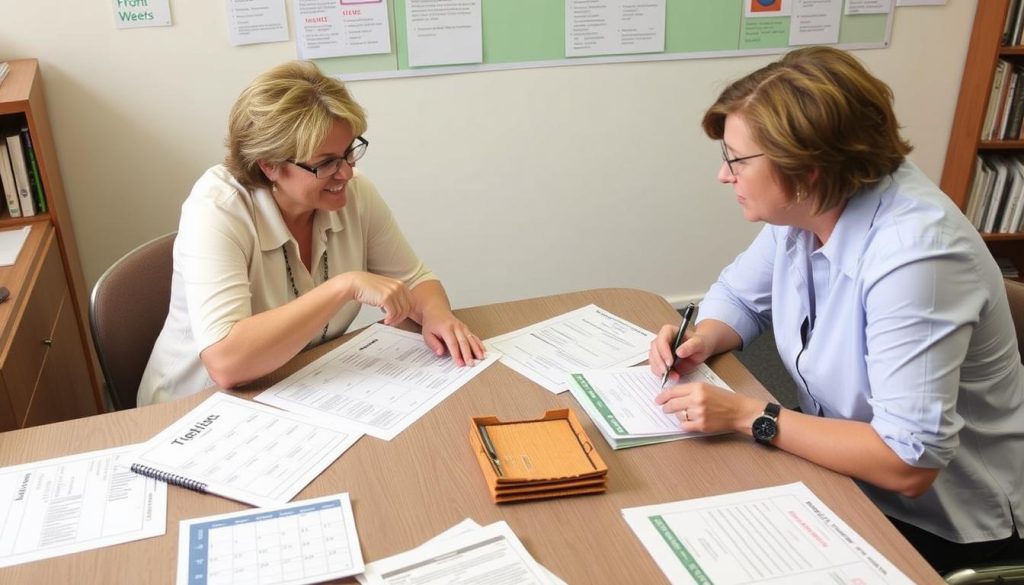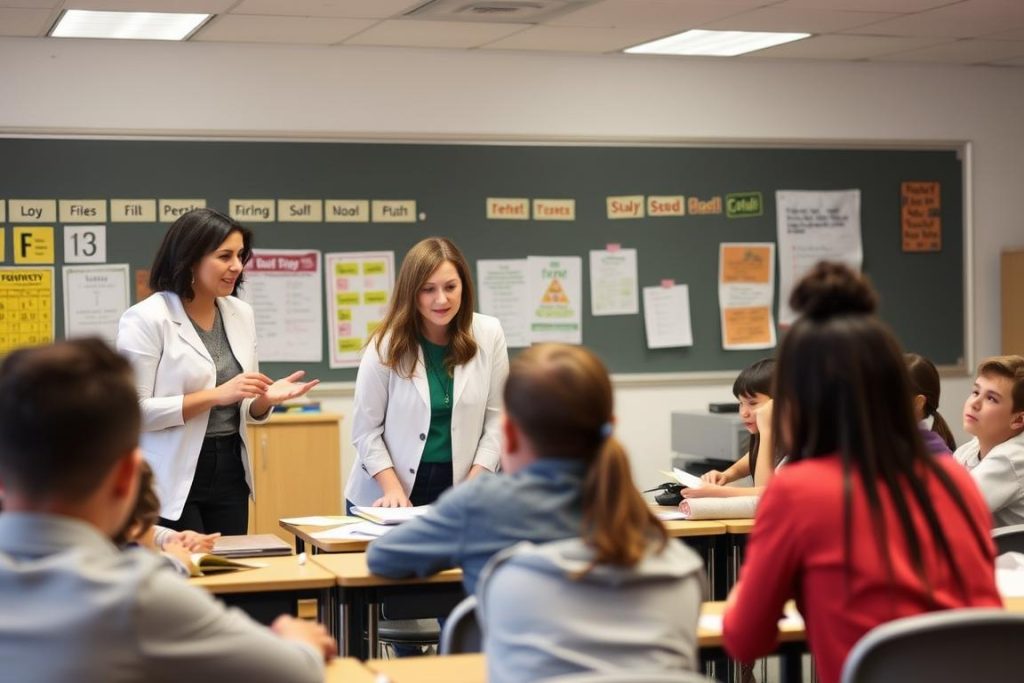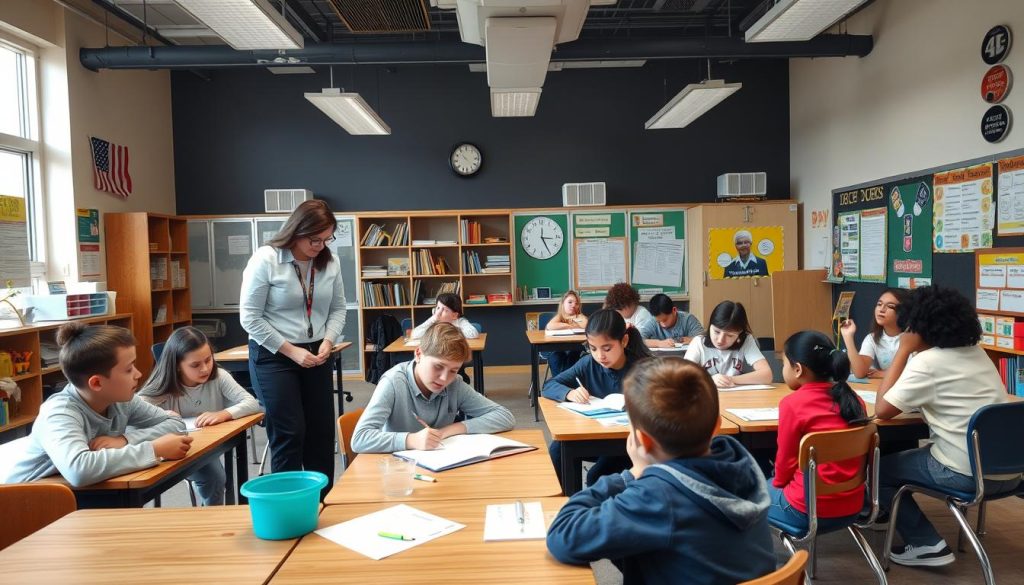In this comprehensive guide, we’ll explore five proven co-teaching strategies and tips that can transform your classroom dynamics and student outcomes. Whether you’re new to co-teaching or looking to refine your existing approach, these practical insights will help you develop essential teacher skills for successful collaboration.
Understanding Co-Teaching: Foundation for Effective Strategies and Tips
Co-teaching occurs when two educators share responsibility for planning, instructing, and evaluating students in a single physical space. According to research from the National Education Association, this collaborative approach can significantly improve student outcomes when implemented with intention and clear communication.
The most successful co-teaching partnerships are built on mutual respect, shared goals, and complementary teacher skills. Before diving into specific strategies and tips, it’s important to recognize that co-teaching comes in various models:
- One teach, one observe – where one teacher leads instruction while the other gathers data
- Station teaching – where students rotate between teacher-led stations
- Parallel teaching – where teachers instruct different groups simultaneously
- Alternative teaching – where one teacher works with a small group while the other leads the main group
- Team teaching – where both teachers deliver instruction together
Each model requires different teacher skills and can be selected based on lesson objectives, student needs, and teacher strengths. Professional development opportunities can help you master these various approaches and earn recognition for your expanded teacher skills.
Strategies and Tips #1: Establish Clear Roles and Responsibilities

One of the most critical strategies and tips for successful co-teaching is establishing clear roles and responsibilities from the outset. When both teachers understand their specific contributions to the classroom, instruction flows more smoothly and students benefit from consistent expectations.
Define Your Teaching Zones
According to research published in the Journal of Educational and Psychological Consultation, co-teachers who clearly define their instructional responsibilities experience less friction and more productive collaboration. Consider dividing responsibilities based on:
Content Expertise
Leverage each teacher’s subject matter strengths. For example, one teacher might lead math instruction while the other focuses on literacy, allowing both to showcase their specialized teacher skills.
Instructional Approach
Assign roles based on teaching styles. One teacher might excel at direct instruction while the other specializes in facilitating small group activities, creating a balanced learning environment.
“When co-teachers take time to clearly define their roles, they create a classroom environment where both educators can fully utilize their teacher skills without stepping on each other’s toes.”
Create a Co-Teaching Agreement
Developing a written co-teaching agreement is one of the most valuable strategies and tips for preventing misunderstandings. This document should outline:
- Who will lead different parts of each lesson
- How classroom management responsibilities will be shared
- When and how planning meetings will occur
- How student assessment will be handled
- Preferred communication methods between teachers
Revisit this agreement regularly throughout the school year to ensure it continues to serve both teachers and students effectively. Developing these collaborative teacher skills takes time but pays dividends in classroom harmony.
Enhance Your Co-Teaching Skills
Looking to strengthen your co-teaching partnership? Our specialized course offers practical strategies for defining roles and responsibilities in any co-teaching environment.
Strategies and Tips #2: Prioritize Collaborative Planning Time

Effective co-teaching doesn’t happen by accident. One of the most important strategies and tips from experienced co-teachers is to protect and prioritize collaborative planning time. Without dedicated time to align on objectives, strategies, and assessment approaches, even the most skilled teachers will struggle to create a cohesive classroom experience.
Finding Time in Busy Schedules
School schedules are notoriously packed, making collaborative planning a challenge. Successful co-teachers employ these strategies and tips to ensure planning happens consistently:
- Request common planning periods from administration
- Use digital tools to collaborate asynchronously when face-to-face time isn’t possible
- Schedule weekly planning meetings (even brief 20-minute sessions can be productive)
- Utilize professional development days for extended planning
- Create planning templates that streamline the process
According to a study by Scruggs, Mastropieri, and McDuffie, dedicated planning time is consistently identified as one of the most critical factors in successful co-teaching arrangements.
Structuring Effective Planning Sessions
Simply finding time isn’t enough—you need to use that time efficiently. Effective planning sessions typically include:
Short-Term Planning
- Review upcoming lessons and units
- Assign specific teaching responsibilities
- Discuss differentiation strategies for diverse learners
- Prepare materials and resources
Long-Term Planning
- Align on curriculum goals and pacing
- Discuss assessment approaches
- Review and adjust co-teaching models based on effectiveness
- Address any ongoing classroom management concerns
Developing efficient planning routines is one of the most valuable teacher skills for co-teaching success. Many teachers report that their planning becomes more efficient over time as they develop shared understanding and communication shortcuts.
Pro Tip: Create a shared digital folder where you store lesson plans, resources, and assessment tools. This makes it easy for both teachers to access materials even when planning happens asynchronously.
Investing in collaborative planning demonstrates respect for both teachers’ expertise and creates a foundation for seamless classroom instruction. When students see a well-coordinated teaching team, they benefit from consistent expectations and comprehensive support.
Strategies and Tips #3: Develop Seamless Classroom Management

Consistent classroom management is essential for creating a productive learning environment. When two teachers share a classroom, aligning on management approaches becomes one of the most crucial strategies and tips for success. Students quickly notice inconsistencies between teachers’ expectations and may become confused or even exploit these differences.
Creating Unified Expectations
Successful co-teachers develop shared classroom management systems that both educators consistently enforce. This requires open discussion about management philosophies and compromise to create a unified approach. Key areas to align on include:
- Classroom procedures and routines
- Behavior expectations and consequences
- Attention signals
- Transition management
- Technology use policies
According to the National Education Association, when co-teachers present a unified front on classroom management, students show improved behavior and increased engagement. This alignment is one of the foundational teacher skills for effective co-teaching.
Balancing Authority in the Classroom
A common challenge in co-teaching relationships is ensuring both teachers are viewed as equal authorities in the classroom. This is especially important when one teacher might be perceived as the “main” teacher due to factors like:
- One teacher being in the classroom full-time while the other splits time between rooms
- One teacher having more experience or seniority
- One teacher having primary content expertise while the other provides specialized support
“Students should never be able to tell which teacher ‘owns’ the classroom. Both educators must have equal standing and authority for co-teaching to reach its full potential.”
Strategies and tips for establishing equal authority include:
Visible Collaboration
Demonstrate respectful collaboration in front of students. Avoid contradicting each other publicly, and show that you value each other’s input and teacher skills.
Shared Leadership
Alternate who leads different classroom activities and routines. Ensure both teachers have opportunities to demonstrate their teacher skills and expertise.
Developing these collaborative teacher skills takes intentional effort but creates a more effective learning environment for all students. When both teachers are viewed as equal authorities, classroom management becomes more consistent and effective.
Master Collaborative Classroom Management
Our specialized co-teaching course includes modules on developing unified classroom management approaches that honor both teachers’ styles while maintaining consistency.
Strategies and Tips #4: Leverage Complementary Teaching Strengths

One of the greatest advantages of co-teaching is the opportunity to leverage two sets of teacher skills and strengths. Rather than trying to teach identically, successful co-teachers recognize and utilize their unique abilities to create a richer learning experience for students.
Identifying Complementary Strengths
Begin by honestly assessing each teacher’s strengths and areas for growth. Consider factors such as:
Instructional Strengths
- Subject matter expertise
- Preferred teaching methods
- Technology proficiency
- Assessment approaches
Interpersonal Strengths
- Relationship building with students
- Parent communication
- Behavior management approaches
- Small group facilitation
According to professional development research, teachers who intentionally leverage complementary strengths report higher job satisfaction and better student outcomes. This strategic approach to co-teaching allows both educators to contribute their best teacher skills to the classroom.
Flexible Co-Teaching Models
One of the most effective strategies and tips for leveraging complementary strengths is to vary your co-teaching models based on lesson objectives and teacher expertise. For example:
- Use team teaching when both teachers have strong content knowledge in the subject area
- Implement station teaching to allow each teacher to focus on their areas of expertise
- Utilize the one teach, one assist model when one teacher has specialized knowledge for a particular lesson
- Apply parallel teaching when both teachers can effectively deliver the same content but want to reduce the student-teacher ratio
Example: In a middle school science class, one teacher with strong lab experience might lead hands-on experiments while the co-teacher with technology expertise manages digital simulations and data collection. Both contribute their specialized teacher skills to create a comprehensive learning experience.
Flexibility is key—the most successful co-teaching partnerships adapt their approach based on lesson content, student needs, and learning objectives. This adaptability is one of the most valuable teacher skills in collaborative settings.
Growing Together Professionally
Beyond leveraging existing strengths, effective co-teaching partnerships create opportunities for professional growth. Consider these strategies and tips for mutual development:
- Observe and provide feedback on each other’s teaching
- Share professional development resources and learnings
- Take turns leading in areas where one teacher wants to develop new skills
- Reflect together on lessons to identify improvement opportunities
This collaborative approach to professional growth enhances both teachers’ skills and creates a dynamic, evolving classroom environment that benefits students.
Strategies and Tips #5: Communicate Effectively and Resolve Conflicts

Even the most compatible co-teaching partners will encounter challenges and disagreements. One of the most valuable strategies and tips for long-term co-teaching success is developing strong communication skills and effective conflict resolution approaches.
Establishing Communication Routines
Regular, honest communication prevents small issues from becoming major problems. Successful co-teachers implement these communication strategies and tips:
- Schedule weekly check-ins focused specifically on the co-teaching relationship
- Create a shared journal or digital document for ongoing notes and reflections
- Develop a system for quick in-class communication (hand signals, note cards, etc.)
- Establish guidelines for giving and receiving feedback
- Set aside time for deeper reflection at natural breaking points (end of units, quarters, etc.)
According to research from the Council for Exceptional Children, co-teachers who prioritize regular communication report higher satisfaction with their partnerships and better classroom outcomes. These communication teacher skills are essential for collaborative success.
Addressing Conflicts Constructively
When disagreements arise, addressing them promptly and professionally is crucial. Effective conflict resolution strategies and tips include:
Focus on Student Needs
Center discussions on what will best serve students rather than personal preferences. This shifts the conversation from personal disagreement to professional problem-solving.
Use “I” Statements
Express concerns in terms of your experience rather than making accusations. For example, “I feel rushed when we change plans last minute” rather than “You always change things at the last minute.”
“The strength of a co-teaching partnership isn’t measured by an absence of conflict, but by how effectively conflicts are resolved when they inevitably arise.”
When conflicts persist despite good-faith efforts to resolve them, consider:
- Seeking mediation from a trusted colleague or administrator
- Revisiting and potentially revising your co-teaching agreement
- Participating in professional development focused on collaboration skills
- Taking a brief pause to reflect individually before reconvening
Developing these conflict resolution teacher skills not only improves your co-teaching relationship but also models healthy communication for students.
Strengthen Your Co-Teaching Partnership
Our comprehensive co-teaching course includes modules on effective communication and conflict resolution specifically designed for educational partnerships.
Implementing These Co-Teaching Strategies and Tips

Successfully implementing these co-teaching strategies and tips requires intentionality and persistence. Rather than trying to transform your practice overnight, consider taking a phased approach:
Getting Started: First Steps
- Begin with a co-teaching agreement – Document your shared understanding of roles, responsibilities, and communication approaches.
- Start with familiar models – Begin with co-teaching approaches that feel comfortable while gradually expanding your repertoire.
- Establish planning routines – Create sustainable systems for collaborative planning that work within your schedule constraints.
- Seek feedback early – Ask students and colleagues for input on what’s working well and what could be improved.
- Celebrate small wins – Acknowledge progress and successful collaboration to build momentum.
Overcoming Common Challenges
Even with the best strategies and tips, co-teachers often encounter these common challenges:
Challenge: Unequal Perception of Authority
- Solution: Explicitly introduce both teachers as equal partners at the beginning of the year
- Solution: Ensure both teachers lead instruction and manage behavior
- Solution: Use inclusive language like “our classroom” rather than “my classroom”
Challenge: Limited Planning Time
- Solution: Create efficient planning templates that can be completed quickly
- Solution: Utilize digital tools for asynchronous planning
- Solution: Advocate with administration for dedicated co-planning time
Developing advanced teacher skills for co-teaching takes time and practice. Be patient with yourself and your co-teacher as you work to implement these strategies and tips in your unique context.
Remember: Effective co-teaching looks different in every classroom. The best partnerships adapt these general strategies and tips to fit their specific students, curriculum, and teaching styles.
For additional support in developing your co-teaching practice, consider professional development opportunities specifically designed to enhance collaborative teacher skills.
Conclusion: Building Lasting Co-Teaching Partnerships
Implementing these five strategies and tips for co-teaching—establishing clear roles, prioritizing planning time, developing seamless classroom management, leveraging complementary strengths, and communicating effectively—creates a foundation for successful collaboration that benefits both teachers and students.
Remember that developing effective co-teaching teacher skills is an ongoing journey rather than a destination. The most successful partnerships continuously reflect, adapt, and grow together. By approaching co-teaching with flexibility, respect, and a commitment to student success, you can create a classroom environment where both teachers thrive professionally and students receive the comprehensive support they need.
As you implement these strategies and tips in your own context, celebrate progress and be patient with the process. The investment you make in developing a strong co-teaching partnership will pay dividends in student engagement, achievement, and your own professional satisfaction.
Take Your Co-Teaching to the Next Level
Ready to enhance your co-teaching practice? Our comprehensive course offers in-depth strategies, customizable templates, and professional development credit for K-12 educators.




